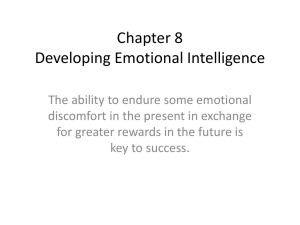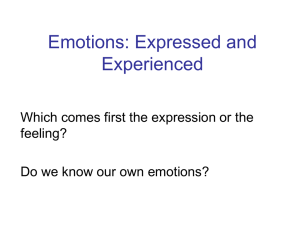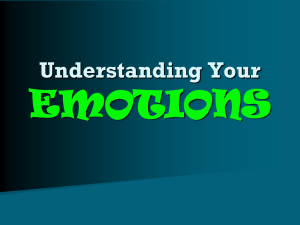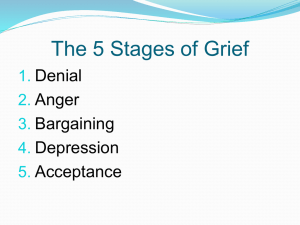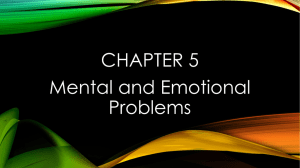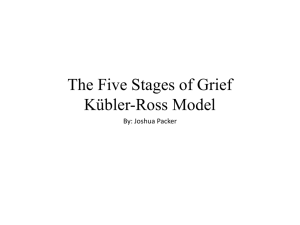Emotional Reactions to People with Mental Illness
advertisement
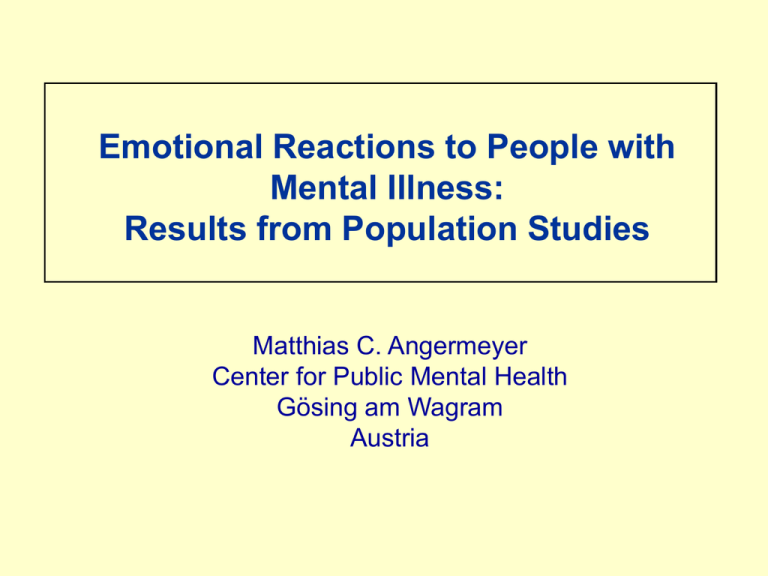
Emotional Reactions to People with Mental Illness: Results from Population Studies Matthias C. Angermeyer Center for Public Mental Health Gösing am Wagram Austria “…Social psychologists have focused upon thoughts (cognition) rather than feelings (affect). … However, the reactions of a host majority acting with prejudice in rejecting a minority group usually involve not just negative thoughts but also emotionally laden attitudes involving anxiety, anger, resentment, hostility, distaste or disgust…In fact, prejudice may more strongly predict discrimination than do stereotypes…Interestingly,…there is almost nothing published about emotional reactions to people with mental illness apart from that which describes a fear of violence …” (Thornicroft & Kassam 2008, 189ff) Systematic Review of Population Studies on Public Beliefs About Mental Disorders and Attitudes Towards the Mentally Ill • Inclusion criteria: - Population studies using random sampling - All languages • Time period covered: 1948 – 2008 • Countries included: 62 • Number of publications: 369 • Number of studies: 261 (137 national, 124 local/regional) Publications on Population Studies on Public Beliefs About Mental Disorder and Attitudes Towards People With Mental Illness (N=369) 110 100 90 80 70 60 50 40 30 20 10 0 46- 49- 52- 55- 58- 61- 64- 67- 70- 73- 76- 79- 82- 85- 88- 91- 94- 97- 00- 03- 0648 51 54 57 60 63 66 69 72 75 78 81 84 87 90 93 96 99 02 05 08 Years Studies on Public Beliefs about Mental Disorders and Attitudes Towards the Mentally Ill (n=261) 1-9 10+ Publications on Population Studies Including Measures of Emotional Reactions N % of all studies (n=261) Perspective of the Stigmatizer ● Positive feelings ● Anxiety ● Anger 15 19 15 5.7 7.3 5.7 Perspective of the Stigmatized ● Shame ● Embarrassment 7 18 2.7 6.9 Total 45 17.2 Components of Modern Conceptualizations of Stigma Link & Phelan 2004 Corrigan & Watson 2002 Thornicroft 2006 Stereotype Ignorance Prejudice Prejudice Labelling Stereotyping Separating Emotional Reactions Status loss + Discrimination Dependence of Stigma on Power Discrimination Discrimination Components of Modern Conceptualizations of Stigma Link & Phelan 2004 Corrigan & Watson 2002 Thornicroft 2006 Stereotype Ignorance Labelling Stereotyping Separating Emotional Reactions Status loss + Discrimination Dependence of Stigma on Power „Prejudice also yields emotional responses (e.g. anger or fear) to stigmatized groups“ „The reactions of a host majority acting with prejudice… involve not just negative thoughts but also emotionally laden attitudes…“ Prejudice Prejudice Discrimination Discrimination The Role of Emotions Seen From the Vantage Point of the Stigmatizer • In personal encounters, the way others respond emotionally tells the stigmatised person how he or she is being perceived. Example: Example:“ “AAperson personwho whofeels feelssome somecombination combinationofofpity pityand andanxiety anxietyin the presence of aofperson withwith mental illness might modulate his his or her in the presence a person mental illness might modulate or voice, speaking softlysoftly and in aninunnaturally calmcalm tone,tone, signalling to the her voice, speaking and an unnaturally signalling person with mental illness that he that or she from a to the person with mental illness he is orbeing she isapproached being approached standpoint of differentness.” (Link et (Link al. 2004) from a standpoint of differentness.” et al. 2004) • Emotional responses may shape subsequent behaviour toward the stigmatised person. Example:AAperson personwho whoreacts reactswith withfear fearmight mightfeel feelaastronger strongerdesire desirefor Example: for social distance avoid contact people mental illness. social distance and and avoid contact with with people with with mental illness. The Role of Emotions Seen From the Vantage Point of the Stigmatized • In interpersonal interaction, how the stigmatised individual responds emotionally may confirm misconceptions held by others. Example: Example:InIninterpersonal interpersonalencounters, encounters,aaperson personashamed ashamedofofher her mental mentalillness illnessmight mightkeep keepher herillness illnessaasecret. secret.Preoccupation Preoccupationwith withhis his ororher herundisclosed undisclosedstatus statusas asmentally mentallyillillperson personmay maylead leadtotoanxiety, anxiety, which whichininturn turnleads leadstotosocial socialawkwardness. awkwardness.This Thismay maylet letothers othersfeel feel uncomfortable uncomfortableand andconfirm confirmtheir theirperception perceptionthat thatpeople peoplewith withmental mental illness illnessare arestrange strangeand andhard hardtototalk talkto. to. • Emotional responses may shape subsequent behaviour of the stigmatised person. Example: Example:Shame Shameand andanxiety anxietymight mightlet letpeople peoplewith withmental mentalillness illnessavoid contact with mental health professionals, resulting in delayed help avoid contact with mental health professionals, resulting in delayed seeking or discontinuation of treatment. help seeking or discontinuation of treatment. • How prevalent are the various emotional reactions to people with mental disorder? • Are there differences between mental disorders as concerns the public’s emotional reactions? • How important are emotional reactions as compared with stereotypes? • Does familiarity with mental illness work through modification of emotional reactions? • How prevalent are the various emotional reactions to people with mental disorder? • Are there differences between mental disorders? • How important are emotional reactions as compared to stereotypes? • Does familiarity with mental illness work through modification of emotional reactions? Emotional Reactions to People With Schizophrenia Population Study in Germany, 2001 % 100 90 80 70 60 50 40 30 20 10 0 ty Pi D ire s e to lp he as e n U ss e in i ty r u ec s In ar e F Em y th a p ck La Positive Emotions of g in d an st r de n u Fear n io t i ta Irr er g An Anger R le cu i id Emotional Reactions to People With Schizophrenia Population Study in Bratislava, 2003 % 100 90 80 70 60 50 40 30 20 10 0 D ire s e to lp he ty Pi i ty r u ec s In U as e n ss e in Em y th a p ar e F n io t i ta Irr ck La Positive Emotions Fear of g in d an st r de n u er g An Anger R le cu i id Emotional Reactions to People With Schizophrenia Population Study in Novosibirsk, 2002 % 100 90 80 70 60 50 40 30 20 10 0 ty Pi D ire s e to lp he as e n U ss e in i ty r u ec s In ck La Positive Emotions ar e F n io t i ta Irr of g in d an st r de n u Fear Em y th a p er g An Anger R le cu i id Emotional Reactions to People With Schizophrenia Population Study in Ulaanbaatar, 2002 % 100 90 80 70 60 50 40 30 20 10 0 ty Pi D ire s e to lp he as e n ss e in ar e F U Positive Emotions g i ty in r d u c n ta se s n r I de n u of ck La n io t i ta Irr Fear Em y th a p er g An Anger R le cu i id Emotional Reactions to People With Major Depression Population Study in Germany, 2001 % 100 90 80 70 60 50 40 30 20 10 0 D ire s e to lp he ty Pi Em y th a p U as e n ss e in i ty r u ec s In ar e F ck La Positive Emotions of g in d an st r de n u Fear n io t i ta Irr er g An Anger R le cu i id Emotional Reactions to People With Major Depression Population Study in Germany, 2001 % 100 90 80 70 60 50 40 30 20 10 0 D ire s e to lp he ty Pi Em y th a p U as e n ss e in i ty r u ec s In ar e F ck La Positive Emotions of g in d an st r de n u Fear n io t i ta Irr er g An Anger R le cu i id Emotional Reactions to People With Major Depression Population Study in Bratislava, 2003 % 100 90 80 70 60 50 40 30 20 10 0 D ire s e to lp he ty Pi Em y th a p i ty r u ec s In as e n ss e in ar e F n io t i ta Irr U ck La Positive Emotions Fear of g in d an st r de n u er g An Anger R le cu i id Emotional Reactions to People With Major Depression Population Study in Novosibirsk, 2002 % 100 90 80 70 60 50 40 30 20 10 0 ty Pi D ire s e to lp he as e n U ss e in i ty r u ec s In n io t i ta Irr ck La Positive Emotions of g in d an st r de n u Em Fear y th a p ar e F er g An Anger R le cu i id Emotional Reactions to People With Major Depression Population Study in Ulaanbaatar, 2002 % 100 90 80 70 60 50 40 30 20 10 0 ty Pi D ire s e to lp he as e n U ss e in i ty r u ec s In ar e F ck La Positive Emotions of g in d an st r de n u Em Fear y th a p n io t i ta Irr er g An Anger R le cu i id Emotional Reactions to People With Schizophrenia Population Studies in the Western Part of Germany, 1990 and 2001 Positive emotions Fear Anger Score Score Score 0,3 0,3 0,3 0,2 0,2 0,2 0,1 0,1 0,1 0 0 0 -0,1 -0,1 -0,1 -0,2 -0,2 -0,2 -0,3 -0,3 -0,3 1990 2001 1990 2001 1990 2001 Emotional Reactions to People With Major Depression Population Studies in the Western Part of Germany, 1990 and 2001 Positive emotions Fear Anger Score Score Score 0,3 0,3 0,3 0,2 0,2 0,2 0,1 0,1 0,1 0 0 0 -0,1 -0,1 -0,1 -0,2 -0,2 -0,2 -0,3 -0,3 -0,3 1990 2001 1990 2001 1990 2001 Emotional Reactions to People With Schizophrenia Population Studies in the Eastern Part of Germany, 1993 and 2001 Positive emotions Fear Anger Score Score Score 0,3 0,3 0,3 0,2 0,2 0,2 0,1 0,1 0,1 0 0 0 -0,1 -0,1 -0,1 -0,2 -0,2 -0,2 -0,3 -0,3 -0,3 1993 2001 1993 2001 1993 2001 Emotional Reactions to People With Major Depression Population Studies in the Eastern Part of Germany, 1993 and 2001 Positive emotions Fear Anger Score Score Score 0,3 0,3 0,3 0,2 0,2 0,2 0,1 0,1 0,1 0 0 0 -0,1 -0,1 -0,1 -0,2 -0,2 -0,2 -0,3 -0,3 -0,3 1993 2001 1993 2001 1993 2001 • How prevalent are the various emotional reactions to people with mental disorder? • Are there differences between mental disorders as concerns the public’s emotional reactions? • How important are emotional reactions as compared to stereotypes? • Does familiarity with mental illness work through modification of emotional reactions? Emotional Reactions to People With Schizophrenia, Major Depression and Alcohol Dependence Population Studies in the Western Part of Germany, 1990 Positive emotions Fear Anger Score Score Score 0,3 0,3 0,3 0,2 0,2 0,2 0,1 0,1 0,1 0 0 0 -0,1 -0,1 -0,1 -0,2 -0,2 -0,2 -0,3 -0,3 -0,3 Schizophrenia Major Depression Alcohol Dependence Emotional Reactions to People With Schizophrenia, Major Depression and Alcoholism Population Studies in the Western Part of Germany, 1990 Positive emotions Fear Anger Score Score Score 0,3 0,3 0,3 0,2 0,2 0,2 0,1 0,1 0,1 0 0 0 -0,1 -0,1 -0,1 -0,2 -0,2 -0,2 -0,3 -0,3 -0,3 Schizophrenia Major Depression Alcoholism Emotional Reactions to People With Schizophrenia, Major Depression and Alcoholism Population Studies in the Western Part of Germany, 1990 Positive emotions Fear Anger Score Score Score 0,3 0,3 0,3 0,2 0,2 0,2 0,1 0,1 0,1 0 0 0 -0,1 -0,1 -0,1 -0,2 -0,2 -0,2 -0,3 -0,3 -0,3 Schizophrenia Major Depression Alcoholism Emotional Reactions to People With Schizophrenia, Major Depression and Alcohol Dependence Population Studies in the Western Part of Germany, 1990 Positive emotions Fear Anger Score Score Score 0,3 0,3 0,3 0,2 0,2 0,2 0,1 0,1 0,1 0 0 0 -0,1 -0,1 -0,1 -0,2 -0,2 -0,2 -0,3 -0,3 -0,3 Schizophrenia Major Depression Alcohol Dependence Emotional Reactions to People With Schizophrenia, Major Depression and Alcoholism Population Studies in the Western Part of Germany, 1990 Positive emotions Fear Anger Score Score Score 0,3 0,3 0,3 0,2 0,2 0,2 0,1 0,1 0,1 0 0 0 -0,1 -0,1 -0,1 -0,2 -0,2 -0,2 -0,3 -0,3 -0,3 Schizophrenia Major Depression Alcoholism • How prevalent are the various emotional reactions to people with mental disorder? • Are there differences between mental disorders? • How important are emotional reactions as compared to stereotypes? • Does familiarity with mental illness work through modification of emotional reactions? Regression of Desire For Social Distance Towards People With Schizophrenia on Socio-Demographic Characteristics, Stereotypes and Emotional Reactions. Population Study in Germany, 2001. Model 1 B Age p Model 2 B p Model 3 B p Model 4 B p .021 .007 .022 .003 .029 .000 .028 .000 Gender -.302 .236 -.253 .279 -.225 .334 -.181 .420 Educational attainment -.319 .049 -.100 .509 .108 .468 -.073 .616 Dangerous 1.019 .000 .680 .000 Unpredictable 1.403 .000 1.036 .000 .394 .699 .011 .351 Lack of willpower Fear 1.781 .000 1.072 .000 Positive emotions -2.154 .000 -1.819 .000 .181 .100 .211 .061 Anger Adj. R² .005 .165 .209 .270 Regression of Desire For Social Distance Towards People With Schizophrenia on Socio-Demographic Characteristics, Stereotypes and Emotional Reactions. Population Study in Germany, 2001. Model 1 B Age p Model 2 B p Model 3 B p Model 4 B p .021 .007 .022 .003 .029 .000 .028 .000 Gender -.302 .236 -.253 .279 -.225 .334 -.181 .420 Educational attainment -.319 .049 -.100 .509 .108 .468 -.073 .616 Dangerous 1.019 .000 .680 .000 Unpredictable 1.403 .000 1.036 .000 .394 .699 .011 .351 Lack of willpower Fear 1.781 .000 1.072 .000 Positive emotions -2.154 .000 -1.819 .000 .181 .100 .211 .061 Anger Adj. R² .005 .165 .209 .270 Regression of Desire for Social Distance Towards People With Schizophrenia on Socio-Demographic Characteristics, Stereotypes and Emotional Reactions. Population Study in Germany, 2001. Model 1 B Age p Model 2 B p Model 3 B p Model 4 B p .021 .007 .022 .003 .029 .000 .028 .000 Gender -.302 .236 -.253 .279 -.225 .334 -.181 .420 Educational attainment -.319 .049 -.100 .509 .108 .468 -.073 .616 Dangerous 1.019 .000 .680 .000 Unpredictable 1.403 .000 1.036 .000 .394 .699 .011 .351 Lack of willpower Fear 1.781 .000 1.072 .000 Positive emotions -2.154 .000 -1.819 .000 .181 .100 .211 .061 Anger Adj. R² .005 .165 .209 .270 Regression of Desire for Social Distance Towards People with Schizophrenia on Socio-Demographic Characteristics, Stereotypes and Emotional Reactions. Population Study in Germany, 2001. Model 1 B Age p Model 2 B p Model 3 B p Model 4 B p .021 .007 .022 .003 .029 .000 .028 .000 Gender -.302 .236 -.253 .279 -.225 .334 -.181 .420 Educational attainment -.319 .049 -.100 .509 .108 .468 -.073 .616 Dangerous 1.019 .000 .680 .000 Unpredictable 1.403 .000 1.036 .000 .394 .699 .011 .351 Lack of willpower Fear 1.781 .000 1.072 .000 Positive emotions -2.154 .000 -1.819 .000 .181 .100 .211 .061 Anger Adj. R² .005 .165 .209 .270 • How prevalent are the various emotional reactions to people with mental disorder? • Are there differences between mental disorders? • How important are emotional reactions as compared to stereotypes? • Does familiarity with mental illness work through modification of emotional reactions? Familiarity with Mental Illness and Desire for Social Distance Systematic Review of Population-Based Studies on Public Beliefs About Mental Disorders and Attitudes Towards the Mentally Ill 30 20 10 0 Positive associations No associations Negative associations Association Between Familiarity, Emotional Reactions and Social Distance Towards People With Schizophrenia Population Study in Germany, 2001 Fear 0.22 Familiarity 0.22 Positive emotions -2.09 Anger -1.60 Sum of indirect effects –1.61 Social distance Association Between Familiarity, Emotional Reactions and Social Distance Towards People With Major Depression Population Study in Germany, 2001 Fear 0.15 Familiarity 0.25 Positive emotions -1.75 Anger -1.31 Sum of indirect effects –1.22 Social distance Summary • Positive emotional responses to people with mental illness are most prevalent, followed by fear and anger. • This pattern appears relatively stable across different cultures. • There are differences in the public’s emotional reactions to the various types of mental disorder. • Emotional reactions have a substantial effect on the desire for social distance. • The association between familiarity with mental disorder and the desire for social distance is to a considerable extent mediated through emotions. Conclusion • As compared to stereotypes and behavioural intentions, the public’s emotional reactions to people with mental disorders are relatively under-researched. • Our findings suggest that more research on the public’s emotional reactions may allow to better understand the complexities of the stigma surrounding mental illness. • Interventions aimed at reducing the stigma of mental illness may benefit from paying more attention to emotions.


